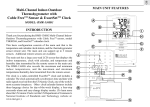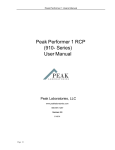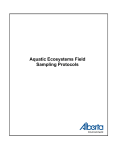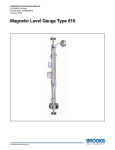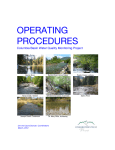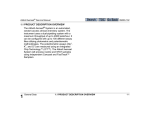Download SOP-026 - Aemera
Transcript
AENV Air Monitoring and Audit Centre Title: Standard Operating Procedure for Measurement of Ethylene (C2H4) in Ambient Air by Reduced Gas Detection (RGD) Procedure No: SOP-026 Revision No: 1.0 January 24, 2011 Page No.: 1 of 10 1. INTRODUCTION AND SCOPE To obtain timely data for the purpose of air quality assessment, air quality trend reporting and to meet the requirements for inclusion of the data in provincial and national air quality databases, a continuous method of analyzing ethylene (C2H4) concentrations in ambient air is used. This method is capable of measurement updates at a rate of once every four minutes for calculations of an hourly average. Commercially available gas chromatography based reduced gas detection (RGD) analyzers are used in the method. This method is applicable to the measurement of C2H4 concentrations in ambient air in the range of 1.0 part per billion (ppb) to select and adjustable ranges up to 5 parts per million (ppm). This method adheres to the requirements of the current Air Monitoring Directive (AMD) drafted by Alberta Environment in 1989. In some cases the limits and specifications exceed the requirements of the current AMD and subsequent amendments. It should be considered that the current and any future amendments or drafts of the AMD will be used as the benchmark for requirements and criteria for ambient air monitoring practices conducted in the Province of Alberta. Information used to write this procedure was also taken from sources identified in the reference section. 2. PRINCIPLE OF THE METHOD The RGA5 Model E-003 is a Gas Chromatograph equipped with a Reduction Gas Detector (RGD). The analyzer column separates the analyzed gas components (combustible gases) before they undergo a reduction reaction with mercuric oxide (HgO). The mercury vapor produced by this reaction is measured by UV absorption using a photometric detector. The amount of mercury vapor is proportional to the amount of ethylene in the sample, and the peak measurement is determined by the retention time through the analyzer column. Specifically: C2H4 + 6HgO (solid) 2H2O + 2CO2 + 6Hg (vapor) Sample Collection The RGA5 is an automated batch analyzer which collects and analyzes a small volume of sample gas approximately once every 240 seconds. The analyzer program includes options that allow only a single sample to be taken, a special sequence to be run (determined by program), or a cycle option which initiates another sample and analysis following completion of a sample. ---THIS DOCUMENT MUST NOT BE PHOTOCOPIED--Additional copies are available from the Air Monitoring Manager or designate AENV Air Monitoring and Audit Centre Title: Standard Operating Procedure for Measurement of Ethylene (C2H4) in Ambient Air by Reduced Gas Detection (RGD) Procedure No: SOP-026 Revision No: 1.0 January 24, 2011 Page No.: 2 of 10 Samples are drawn into the analyzer using a pump system where a 6-port, two position rotary valve is used to control the distribution of sample gas to the analyzer and the column and finally through a mercury oxide bed and the reduced gas detector (see figure 2.0). There are two valve positions or modes, which are referred to as the “INJECT” and “LOAD”. The cycle starts with the LOAD mode. The sample is drawn into the sample loop (see Figure 2.1) to bring in a nominal amount of sample for analysis. The rotary valve then switches to the INJECT position to allow the carrier gas to separate the gas compounds within the sample (see Figure 2.2). The valve connects the sample loop to the column and the sample is pushed through the column by the carrier gas. The known weight of the ethylene molecule will separate in the column based on the length of the column and the regulated temperature maintained. Once separated, the ethylene will enter a heated bed of mercury where proportional amounts of mercury oxide vapour will be exchanged and released into the chamber for analysis. Photometric Detector Mercury oxide will absorb ultra-violet light at 254 nanometers wavelength. A ultra-violet lamp is placed on one side of the measurement chamber and the strength of the 254 nm wavelength is measured at the source. A secondary sensor will also measure this wavelength at the opposite end of the reaction chamber. The difference of measured light is proportional to the concentration of the reduced gas. Gas Chromatogram Typical measurement principles of GC based measurements incorporate either: a) height of the sample response output or b) the area of the sample response. The RGA5 analyzer measures the area of the signal response as determined by the retention times set by the operator. The signal is then amplified and converted to an analog output signal which is held constant between sample measurements. Once the mercury has been detected by the RGD, the rotary valve then reverses returning to the LOAD mode to collect a new sample for analysis. The mercury sample in the measurement chamber is also exhausted to a charcoal scrubber to safely remove the mercury. This completes the sample gas cycle. The time required for the analysis of one sample is about 240 seconds. ---THIS DOCUMENT MUST NOT BE PHOTOCOPIED--Additional copies are available from the Air Monitoring Manager or designate AENV Air Monitoring and Audit Centre Title: Standard Operating Procedure for Measurement of Ethylene (C2H4) in Ambient Air by Reduced Gas Detection (RGD) Procedure No: SOP-026 Revision No: 1.0 January 24, 2011 Page No.: 3 of 10 Figure 2.0: Reduction Gas Detector ---THIS DOCUMENT MUST NOT BE PHOTOCOPIED--Additional copies are available from the Air Monitoring Manager or designate AENV Air Monitoring and Audit Centre Title: Standard Operating Procedure for Measurement of Ethylene (C2H4) in Ambient Air by Reduced Gas Detection (RGD) Procedure No: SOP-026 Revision No: 1.0 January 24, 2011 Page No.: 4 of 10 Figure 2.1: Load Flow Path Figure 2.2: Inject Flow Path ---THIS DOCUMENT MUST NOT BE PHOTOCOPIED--Additional copies are available from the Air Monitoring Manager or designate AENV Air Monitoring and Audit Centre Title: Standard Operating Procedure for Measurement of Ethylene (C2H4) in Ambient Air by Reduced Gas Detection (RGD) Procedure No: SOP-026 Revision No: 1.0 January 24, 2011 Page No.: 5 of 10 3. MEASUREMENT RANGE AND SENSITIVITY The C2H4 analyzers used in this method are commercially available models. The measurement range is user selectable. Any range may be utilized providing it is higher than the 1040 ppb exceedence level. The detection limit of the analyzer is specified by the manufacturer. Generally it is at the 1 ppb level for C2H4. 4. EQUIPMENT AND APPARATUS The following are available commercial analyzers suitable for used in this method and are currently in use in Alberta or the AENV network: Peak Performer 1 Trace Analytical RGA-5 Model E-003 This list does not exclude the use of other equipment that has received the USEPA Reference and Equivalent Method designation. 5. INTERFERENCES As this system is GC based, any compounds detectable by the RGD are typically retained on the column and then flushed off the column during the Load cycle. Particulate matter may interfere with analyzer response. This problem is normally eliminated by using a particle filter of 2.0µm pore size made of inert material, such as Teflon, at the sample inlet of the instrument. Impurities in the carrier gas may cause problems with the sample analysis. Gas compounds in the carrier other than the manufacturer approved list may react with the mercury bed causing false readings. The RGA5 will detect hydrogen and carbon monoxide impurities present in the carrier gas, however the analyzer uses retention times to eliminate any peaks in the gas chromatogram that are not related to the Ethylene being measured. Typically the ethylene retention time is set between 175 and 200 seconds based on a 240 second run. At a given carrier flow rate, the concentration of mercury vapor entering the photometer cell is dependant on two processes: ---THIS DOCUMENT MUST NOT BE PHOTOCOPIED--Additional copies are available from the Air Monitoring Manager or designate AENV Air Monitoring and Audit Centre Title: Standard Operating Procedure for Measurement of Ethylene (C2H4) in Ambient Air by Reduced Gas Detection (RGD) Procedure No: SOP-026 Revision No: 1.0 January 24, 2011 Page No.: 6 of 10 1. Thermal dissociation of mercuric oxide to free mercury vapor 2. Oxidation of reducing gases on the HgO bed. These reactions proceed: 2HgO 2Hg (vapor) + O2 and X + HgO Hg (vapor) + XO The rate of each of these reactions is temperature dependant, and not all compound reactions proceed to complete oxidation. The thermal dissociation rate to Hg (vapor) roughly doubles for every 10°C increase in HgO (detector) temperature. For the oxidation of H2 gas, the reaction does not proceed fully at temperatures below the sublimation point of HgO (315°C), although higher detector temperatures do increase H2 sensitivity. The nominal detector operating temperature of 265°C has been selected on a basis of compromise of several of these factors. 6. PRECISION AND ACCURACY The measurement precision is generally considered to be the “repeatability of the measurement”. Precision of the data output by the analyzer is established by the manufacturer, but confirmed during daily span checks and monthly calibrations. See section 9.0 in this document for information on daily calibration checks. The accuracy of the sensor is generally considered the “deviation from true”. This means how close it is to what it should be. The benchmark of “what it should be” is provided by the Alberta Environment Audit Program staff and the use of high quality standards such as available from the National Institute of Standards and Technology (NIST). As with precision, accuracy and repeatability is confirmed by the daily span and monthly calibration checks. Refer to the sections identified above for further information on accuracy relating to calibration and audit procedures. 7. SITE REQUIREMENTS Site location for C2H4 monitoring should be determined according to the intended application of the monitoring data. Detailed requirements for selection of sites for monitoring ambient C2H4 can be found in the Site Selection Criteria of the AMD. ---THIS DOCUMENT MUST NOT BE PHOTOCOPIED--Additional copies are available from the Air Monitoring Manager or designate AENV Air Monitoring and Audit Centre Title: Standard Operating Procedure for Measurement of Ethylene (C2H4) in Ambient Air by Reduced Gas Detection (RGD) Procedure No: SOP-026 Revision No: 1.0 January 24, 2011 Page No.: 7 of 10 8. INSTALLATION REQUIREMENTS All the installation requirements are specified by the manufacturer in the installation procedures of the manual. General requirements listed below must also be followed. Considerations for siting requirements can be found in the reference listed in section 7.0 above. 8.1 The ¼ inch outside diameter (inside diameter of 3/16 inch or 1/8 inch) connection tubing from the manifold to the analyzer inlet must be made of Teflon or equivalent material for chemical inertness. 8.2 A Teflon or glass fibre particulate filter with a pore size of no larger than 5.0µm must be placed in the sampling line before the air sample enters the detection cells and is recommended to be located as close as possible to the inlet manifold. The holder for such filter must also be made of Teflon, stainless steel or delrin. 8.3 A data acquisition system (DAS) should be connected to the analyzer to record or download the signal output from the analyzer. For connection to record analog voltage signals, the system should be set to match the voltage range of the analyzer output. Note that the full scale output of the RGA5 is not truly 10V; each analyzer maximum output should be measured and the system scaled appropriately to account for this. See the DAS operations manual for instructions on configuring these channels. 8.4 The analyzer has the capability to output specific alarms or a general alarm via a contact closure. These outputs are connected to the digital input section of the DAS. See the DAS operations manual for instructions on configuring these channels. 8.5 The monitoring station temperature should be controlled within the range of 15 to 30°C. It is important to note that the analyzer will operate properly at any temperature within this range; however, the stability of the station temperature is most important. 8.6 Range Set – The typical range selection used in Alberta is set above 1040 ppb level as this is the hourly exceedence level. This range is set independently and is decided on a per site basis. There are no pre selected ranges to choose from in this model. The selected upper range should be set as soon as the analyzer is powered up after installation. Refer to the operations manual for instructions on this procedure. ---THIS DOCUMENT MUST NOT BE PHOTOCOPIED--Additional copies are available from the Air Monitoring Manager or designate AENV Air Monitoring and Audit Centre Title: Standard Operating Procedure for Measurement of Ethylene (C2H4) in Ambient Air by Reduced Gas Detection (RGD) Procedure No: SOP-026 Revision No: 1.0 January 24, 2011 Page No.: 8 of 10 9. OPERATIONAL REQUIREMENTS The following activities must be performed when operating a continuous automated C2H4 analyzer in Alberta. All operational activities conducted at any ambient monitoring station must be documented in the station logbook, and/or station checklists. This allows other operators to access a history of the station if the regular technician is not available. The following documentation must be available to the operators on site: operational and maintenance manual(s), quality system manual and station site documentation. 9.1 Daily Requirements Zero/Span Check – a zero/span cycle is required every day to verify the analyzer’s performance. This involves diverting the sample flow of the analyzer so that the analyzer subsequently samples zero air for the zero cycle and air with a known amount of C2H4 for the span cycle. The zero source is typically provided by a zero air system consisting of a compressor, air dryer and a high temperature oxidizer for removal of hydrocarbons or a cylinder of zero air, and span by a cylinder of C2H4 in the appropriate range. This cycle can either be controlled by the station DAS or by the analyzer sequence program. It is recommended to run the zero cycle after the span in order to reduce settling time after the check since zero levels are normally closest to ambient measurements. Refer to the analyzer manual for more information. 9.2 Analyzer Test Parameters The analyzer monitors and displays test functions in order for the operator to monitor the performance of specific systems within the analyzer. These test parameters should be monitored on a weekly basis and recorded on a site checklist. Support gasses of Nitrogen (N2) or Ultra Zero Air (UZA) are required in the absence of a zero air generation system for the operation of these analyzers. Pressures of these cylinders should be monitored routinely so that cylinders are changed before they run empty. A good “rule of thumb” is to change the cylinders once they drop below 500 psi. See controlled documents for an example of a station checklist. 9.3 Inlet Filter Change The sample inlet filter is typically replaced when the monthly multipoint calibration is being done. The filter change is completed after the as found points have been completed and before the multipoint calibration is carried out. This is done to establish a reference prior to the removal of the filter. ---THIS DOCUMENT MUST NOT BE PHOTOCOPIED--Additional copies are available from the Air Monitoring Manager or designate AENV Air Monitoring and Audit Centre Title: Standard Operating Procedure for Measurement of Ethylene (C2H4) in Ambient Air by Reduced Gas Detection (RGD) Procedure No: SOP-026 Revision No: 1.0 January 24, 2011 Page No.: 9 of 10 9.4 Analyzer Maintenance Preventative maintenance tasks should be completed on the analyzer on a periodic basis. These tasks are outlined in the operations manual. A strict regiment of these tasks should be adhered to as they are intended to fix a problem before it happens. Any maintenance must be recorded in the station log book and/or the electronic logbook. This is also recorded in the instrument log that accompanies each instrument. 9.5 Multipoint Calibration Multipoint calibrations are conducted on the C2H4 analyzer to verify precision, accuracy and linearity of the instrument. This procedure must be completed after the analyzer has been installed following at least a 24 hour warm up period, and monthly to comply with Alberta Environment regulations. This procedure is also completed after any major maintenance to confirm the precision and accuracy after repairs. Calibration procedures specific to the C2H4 analyzer are found in section 10 of this document. 9.6 Analyzer Audit C2H4 analyzers operating in Alberta are required to undergo an on-site audit once per year. This audit involves the Alberta Environment Audit Program staff visiting the site with the NIST traceable standards to verify the accuracy and linearity of the instrument. 10. CALIBRATION The calibration procedure for C2H4 analyzers is similar to calibration of other continuous ambient air analyzers. This procedure involves generating a known amount of C2H4 blended with zero air, which is introduced to the analyzer to verify its performance. There are certain specifics to the C2H4 calibration that are identified in this section. 10.1 Calibration Equipment – C2H4 analyzers are typically calibrated using the dilution method. 10.2 Referring to the calibration procedure outlined in SOP#11 Dilution Calibrations, calculate the slope and intercept of the 4 data points for as determined by the data acquisition response against the calibrator values using linear regression analysis. The acceptance criteria are slope of 1.0 ±/0.1 and intercept of ± 3% full scale and a coefficient of correlation (CC) >0.998. 10.3 A zero/span check cycle is run through the DAS following the calibration to verify the internal span values and zero readings. ---THIS DOCUMENT MUST NOT BE PHOTOCOPIED--Additional copies are available from the Air Monitoring Manager or designate AENV Air Monitoring and Audit Centre Title: Standard Operating Procedure for Measurement of Ethylene (C2H4) in Ambient Air by Reduced Gas Detection (RGD) Procedure No: SOP-026 Revision No: 1.0 January 24, 2011 Page No.: 10 of 10 11. APPLICABLE DOCUMENTS EM-026a Trace Analytical RGA5 Ethylene Analyzer Service Manual EM-026b Trace Analytical RGA5 Basic Operator Training, Maxxam Analytics – May 1999. EM-026c Peak Performer 1 Users Manual 12. LITERATURE REFERENCES None 13. REVISION HISTORY Revision 0 (new document) Revision 1 Grammatical changes, refer to SOP #11 in section 10.2 14. APPROVAL Approved by: Harry Benders Title: Air Monitoring Manager Date: Janaury 24, 2011 ---THIS DOCUMENT MUST NOT BE PHOTOCOPIED--Additional copies are available from the Air Monitoring Manager or designate













